Saturday: Book/DVD signing at Gray Ghost Winery
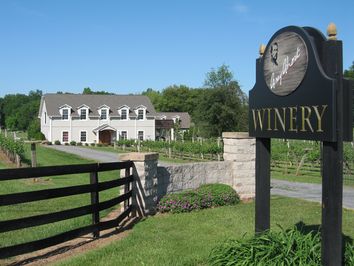 On Saturday I will be making my third appearance at Gray Ghost Winery’s annual “Civil War Authors Day.” This year I will be signing 2 books and 1 DVD. I am also presenting a brief talk on Richard Kirkland as part of their author vignettes.
On Saturday I will be making my third appearance at Gray Ghost Winery’s annual “Civil War Authors Day.” This year I will be signing 2 books and 1 DVD. I am also presenting a brief talk on Richard Kirkland as part of their author vignettes.
This FREE event is on Saturday, November 19, 2011 from 11:00 am to 5:00 pm. For more information, visit their website at www.grayghostvineyards.com.
Posted by ny5/pinstripepress
at 10:01 AM EST
Updated: Tuesday, 15 November 2011 11:37 AM EST
Permalink |
Share This Post
Mort's next masterpiece
This Saturday I will be joining my friend (and favorite client) Mort Kunstler here in Fredericksburg. Mort will be signing his new 2011 snow print “How Real Soldiers Live” at my friend Terry Thomann’s Civil War Life Museum Store (829 Caroline Street) from 10 am until 3 pm. Mort’s newest project is one that I will be covering in detail here at Blog, or Die. It is an accurate representation of Washington’s crossing of the Delaware. According to Mort himself, this will be the painting that he is best remembered for years from now. I will post some pictures of the Sat. event next week.
Below: "The Spirit" by Bill Bleyer for Newsday October 9, 2011
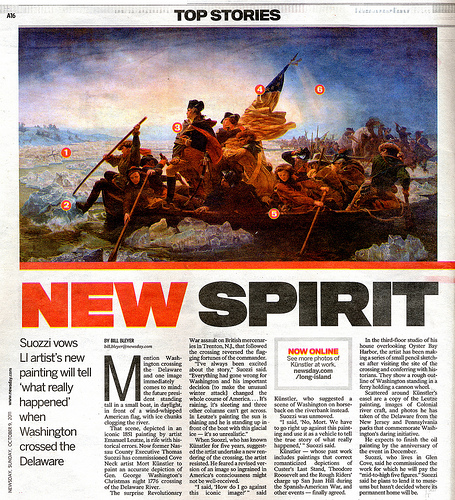
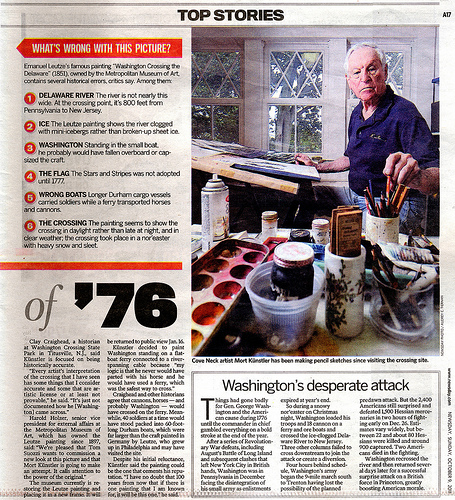
Posted by ny5/pinstripepress
at 8:27 AM EST
Updated: Thursday, 10 November 2011 11:03 AM EST
Permalink |
Share This Post
Now available online

With the War of 1812 Bicentennial fast-approaching, folks all across our country and in Canada (especially in Canada) are preparing a series of programs to commemorate one of the most overlooked wars in American history. You may recall a recent movie review that I posted on the new PBS film “The War of 1812.” A production of WNED (Toronto), Florentine Films/HOTT Productions, in association with WETA, Washington DC, “The War of 1812” is a 2-hour documentary that not only presents a historical look at the conflict, but also how it has been remembered and forgotten today. The film includes interviews with 26 leading American, British, Canadian and Native historians, first-hand accounts, battle re-enactments and period artwork which all help to define this war. In addition to battlefield exploits, the experiences of civilians and politicians are included. This includes familiar characters such as the Indian warrior Tecumseh and first lady Dolley Madison.
You can now watch the entire 2-hour film online at PBS and view a series of special bonus features and behind-the-scenes material. I have only begun to study the War of 1812 and believe it to be incredibly important when understanding how America established its early diplomacy and maintained its independence after the Revolution. The War of 1812 was also the seminal event that defined James Madison’s presidency. I am especially interested to see how our neighbors in the “Great White North” acknowledge this war, as it seems to mean a lot more to them than it does to us. Future posts may look at the Canadian perspective and interpretation.
Crossover-post from All-Access Battlefield Tours
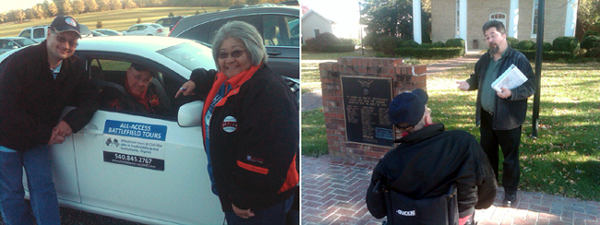
This weekend AABT had the privilege of conducting a special two-battlefield tour for an extraordinary couple from Oregon, Mike and Irene Brashear. Mike was a combat photographer who served in the U.S. Army in Vietnam from 1966-69 and Irene is the proud daughter of an Okinawan-American, US Army, MIS WW2 veteran. The Brashears were in town attending the Congressional Gold Medal Ceremony for Irene’s father with the 100th, 442nd, and MIS Japanese American veterans in Washington DC. No strangers to memorials themselves, both have been instrumental in the founding and establishment of the Vietnam Era Veterans’ Memorial (Read Article) back in Oregon.Our tour covered the Fredericksburg and Spotsylvania Battlefields and focused on the Sunken Road, Spotsylvania Courthouse area, and of course the Bloody Angle. What started out as a 5 hour tour ended in 7 as we had such a tremendous time together. Michael Aubrecht provided a detailed presentation for the Fredericksburg portion and John Cummings presented his original research at Spotsylvania’s hallowed grounds. Stops were also made at Stevenson Ridge and the Confederate Cemetery. AABT thanks the Brashears for their patronage, generosity, and for providing us with a wonderful day.
Op-Ed: John Taylor, Capitalism, and Occupy Wall Street
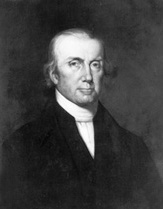 Whether one agrees or disagrees with the premise, the Occupy Wall Street Movement has at the very least, made us all think. It has brought the very concept of social-economics under the scrutiny of the public and identified a clear discrepancy in the way that many Americans view our current financial system. No doubt instigated by the country’s current economic and unemployment debacle, many participants (and observers) of the “Occupy-Movement” are now wondering if a radical change is necessary in order to remedy the country’s fiscal condition.
Whether one agrees or disagrees with the premise, the Occupy Wall Street Movement has at the very least, made us all think. It has brought the very concept of social-economics under the scrutiny of the public and identified a clear discrepancy in the way that many Americans view our current financial system. No doubt instigated by the country’s current economic and unemployment debacle, many participants (and observers) of the “Occupy-Movement” are now wondering if a radical change is necessary in order to remedy the country’s fiscal condition.
One of the most highly debated items at the top of their list is the practice for/against capitalism, the very keystone in the foundation of the country’s economic engine. This argument has split the proponents and critics of OWS further into two groups: those who oppose modern capitalism and those who vow to maintain it. Some folks vehemently believe that the current system is broken, while others feel that it was always destined to fail. Although OWS has splintered off into a variety of “causes,” one of the root beliefs of the movement was the unfair influence that wealthy (aka big business) has over the U.S. Government.
As a historian, I find it fascinating that one of our nation’s earliest politicians and political commentators may have predicted this dilemma well over 200 years ago. John Taylor of Caroline County, Virginia, predicted the problems of modern state capitalism and central banking. Both a successful politician and writer, Taylor served in the VA House of Delegates (1779–81, 1783–85, 1796–1800) and in the U.S. Senate (1792–94, 1803, 1822–24). He is considered by experts to be a Jeffersonian Democrat, although he participated in the Anti-Administration; Democratic Republican; Democratic Republican; and Crawford Republican parties. He also published multiple books on politics and agriculture, some of which have been credited with inspiring the States’ Rights and Libertarian parties.
It must be stated that Taylor was NOT an Anti-Capitalist, nor was he against a Free-Market system. He was however, an adamant critic of the way in which the governing-system could be overly-financed and manipulated by the rich. According to Thorton Miller’s Foreword in the re-released version of Taylor’s 1822 publication Tyranny Unmasked, (ed. F.Thornton Miller (Indianapolis: Liberty Fund, 1992):
A note of explanation is needed for Taylor's use in Tyranny Unmasked of the term “capitalists” to describe his opponents. When he began writing in the 1790s, he was more likely to use the phrase “monied aristocracy” to describe his enemies. Thirty years later, he believed the Constitution, Hamilton, Federalists, and Republican party moderation and compromise had allowed an aristocracy of wealth to rise in America. In America, instead of titled nobles, the lords were financiers. Instead of members of the House of Lords, they were the stockholders of the Bank of the United States. By the writing of Tyranny Unmasked, Taylor was using the more economic-sounding term, “capitalists,” to refer to these aristocrats. But, he was not opposed to capitalism, and he often cited Adam Smith and capitalist economists in his works, including this one. Like Adam Smith, Taylor opposed government intervention in the economy and wanted a natural economy, a free market system. Taylor opposed those capitalists who were not satisfied with natural economics and who sought to benefit through government intervention. He described his opponents more precisely when he used such phrases as “manufacturing capitalists” or “protective duty capitalists.”
There was, however, a major aspect of capitalism that Taylor rejected. He would not condone the potential pluralism of the capitalist, liberal, or free market theory: an America consisting of competing interests. For Taylor, the only good interest was natural and productive, and, in America, where the vast majority were farmers, that was agriculture, which should remain predominant. He was an agrarian first and foremost; he was a capitalist as long as most capital was going into agriculture. He believed there were fundamental principles in economics just as in politics. “Among these principles,” he writes in Tyranny Unmasked, “the most important is, that land is the only, or at least the most permanent source of profit; and its successful cultivation the best encourage of all other occupations, and the best security for national prosperity.”
Taylor “opposed those capitalists who were not satisfied with natural economics and who sought to benefit [themselves] through government intervention.” In other words, these types of capitalists (aka the 1%) could essentially purchase their way into a position of influence over the government, who would in turn, rule in a way that would benefit their own financial interests. Sound familiar? That logic (to me) is pretty simple: Capitalism works, but perhaps not American Capitalism (as it stands) which enables one class of income to unfairly dictate over another. In that regard, perhaps we can gain some new insight by listening to the folks at OWS. We should at least think about it. John Taylor did.
Perhaps this sign best explains this argument:
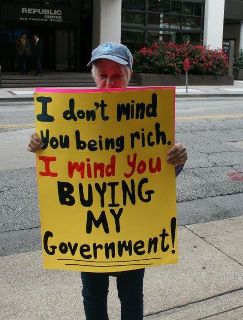
Posted by ny5/pinstripepress
at 11:01 AM EDT
Updated: Thursday, 3 November 2011 12:02 PM EDT
Permalink |
Share This Post
 On Saturday I will be making my third appearance at Gray Ghost Winery’s annual “Civil War Authors Day.” This year I will be signing 2 books and 1 DVD. I am also presenting a brief talk on Richard Kirkland as part of their author vignettes.
On Saturday I will be making my third appearance at Gray Ghost Winery’s annual “Civil War Authors Day.” This year I will be signing 2 books and 1 DVD. I am also presenting a brief talk on Richard Kirkland as part of their author vignettes. 









 Whether one agrees or disagrees with the premise, the Occupy Wall Street Movement has at the very least, made us all think. It has brought the very concept of social-economics under the scrutiny of the public and identified a clear discrepancy in the way that many Americans view our current financial system. No doubt instigated by the country’s current economic and unemployment debacle, many participants (and observers) of the “Occupy-Movement” are now wondering if a radical change is necessary in order to remedy the country’s fiscal condition.
Whether one agrees or disagrees with the premise, the Occupy Wall Street Movement has at the very least, made us all think. It has brought the very concept of social-economics under the scrutiny of the public and identified a clear discrepancy in the way that many Americans view our current financial system. No doubt instigated by the country’s current economic and unemployment debacle, many participants (and observers) of the “Occupy-Movement” are now wondering if a radical change is necessary in order to remedy the country’s fiscal condition.